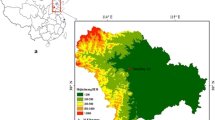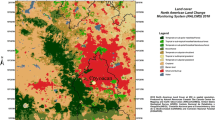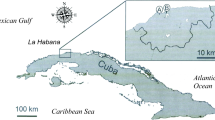Abstract
Pollen is an important cause of allergic respiratory ailments in the Mexico City Metropolitan Area (MCMA). However, very little is known if ambient air temperature correlates with the early blooming of plants observed in other urban areas around the world. A research study was conducted during the dry season of 2012–2013 at three representative sites of the MCMA with different urban characteristics with the aim to understand the relationships between the profusion and diversity of pollen against temperature and other meteorological variables and degree of urbanization. Pollen samples were collected using a Hirst-type trap sampler in the sites: Merced (highly urbanized), Iztapalapa (medium-high urbanized) and Coyoacan (moderately urbanized). Urbanization levels were determined using a composite index based on population density, proportion of surface covered by construction and asphalt, and urban heat island intensity. A set of representative pollen sampling tapes were assayed under a light microscope at magnification of ×1,000 and converted to grains per cubic meter. The most representative pollen types found in the three sites were, regardless of urbanization levels were: Fraxinus, Cupressaceae/Taxodiaceae, Casuarina, Alnus, Myrtaceae, and Pinus. Total pollen concentration was greatest in the moderately urbanized area, although earlier blooming took place at the highly urbanized zone. Total pollen concentration in the medium-high urbanized site has the lowest because the green areas in this zone of MCMA are few. In a diurnal basis, the most abundant pollen types peaked near midday or in the afternoon evening at the three sites. A Spearman test showed a positive correlation among bihourly pollen concentrations, temperature and relative humidity in all sites, but wind speed just correlated in Iztapalapa and Coyoacan. The results obtained suggest that Urban Heat Island Intensity can disturb flowering periods and pollen concentrations, largely in the highly urbanized areas. A principal components analysis established that the concentrations of each pollen type differed across the urbanization gradients. Additionally, it was found that a large number of allergenic pollens are produced by ornamental trees, some only recently introduced by urban planners.






Similar content being viewed by others
References
Argáez Márquez O (1996) Estudio aerobiológico en la zona urbana de la ciudad de Aguascalientes. Invest Cienc Univ Autónoma Aguascalientes 5:21–26
Baran H, Ozcan KM, Selcuk A et al (2014) Allergic rhinitis and its impact on asthma classification correlations. J Laryngol Otol 128:431–437. doi:10.1017/S0022215114000693
Bartra J, Sastre J, Del Cuvillo A et al (2009) From pollinosis to digestive allergy. J Investig Allergol Clin Immunol 19:3–10
Bosch-Cano F, Bernard N, Sudre B et al (2011) Human exposure to allergenic pollens: a comparison between urban and rural areas. Environ Res 111:619–625
Bravo H, Torres R, Sosa R (1988) Ozone and its nighttime concentration in the southern Mexico City metropolitan area. Geofis Int 27:83–98
Buseck PR, Posfai M (1999) Airborne minerals and related aerosol particles: effects on climate and the environment. Proc Natl Acad Sci 96:3372–3379. doi:10.1073/pnas.96.7.3372
Buyantuyev A, Wu J (2010) Urban heat islands and landscape heterogeneity: linking spatiotemporal variations in surface temperatures to land-cover and socioeconomic patterns. Landsc Ecol 25:17–33. doi:10.1007/s10980-009-9402-4
Calderon C, Lacey J, McCartney A, Rosas I (1997) Influence of urban climate upon distribution of airborne Deuteromycete spore concentrations in Mexico City. Int J Biometeorol 40:71–80. doi:10.1007/s004840050021
Calderon C, Lacey J, McCartney HA, Rosas I (1995) Seasonal and diurnal variation of airborne basidiomycete spore concentrations in Mexico City. Grana 34:260–268. doi:10.1080/00173139509429055
Cariñanos P, Casares-Porcel M (2011) Urban green zones and related pollen allergy: a review. Some guidelines for designing spaces with low allergy impact. Landsc Urban Plan 101:205–214
Chacalo A, Aldama A, Grabinsky J (1994) Street tree inventory in Mexico City. J Arboric 20:222–226
D’Amato G, Cecchi L (2010) Urban air pollution and climate change as environmental risk factors of respiratory allergy: an update. J Invest 20:95–102
D’Amato G, Cecchi L (2008) Effects of climate change on environmental factors in respiratory allergic diseases. Clin Exp Allergy 38:1264–1274
D’Amato G, Cecchi L, Bonini S et al (2007) Allergenic pollen and pollen allergy in Europe. Allergy 62:976–990
Dahmann N, Wolch J, Joassart-Marcelli P et al (2010) The active city? Disparities in provision of urban public recreation resources. Health Place 16:431–445. doi:10.1016/j.healthplace.2009.11.005
De Vizcaya-Ruiz A, Gutiérrez-Castillo ME, Uribe-Ramirez M et al (2006) Characterization and in vitro biological effects of concentrated particulate matter from Mexico City. Atmos Environ 40:583–592. doi:10.1016/j.atmosenv.2005.12.073
Després VR, Alex Huffman J, Burrows SM et al (2012) Primary biological aerosol particles in the atmosphere: a review. Tellus Ser B Chem Phys Meteorol 64:1–40. doi:10.3402/tellusb.v64i0.15598
Escobedo FJ, Kroeger T, Wagner JE (2011) Urban forests and pollution mitigation: analyzing ecosystem services and disservices. Environ Pollut 159:2078–2087. doi:10.1016/j.envpol.2011.01.010
Frei T, Gassner E (2008) Climate change and its impact on birch pollen quantities and the start of the pollen season an example from Switzerland for the period 1969–2006. Int J Biometeorol 52:667–674. doi:10.1007/s00484-008-0159-2
Gioulekas D, Balafoutis C, Damialis A et al (2004) Fifteen years’ record of airborne allergenic pollen and meteorological parameters in Thessaloniki, Greece. Int J Biometeorol 48:128–136
Gonzalez-Diaz SN, Rodriguez-Ortiz PG, Arias-Cruz A et al (2010) Atmospheric pollen count in Monterrey, Mexico. Allergy Asthma Proc 31:341–348. doi:10.2500/aap.2010.31.3340
Grimm NB, Faeth SH, Golubiewski NE et al (2008) Global change and the ecology of cities. Science 319(80):756–760
Guvensen A, Ozturk M (2003) Airborne pollen calendar of Izmir—Turkey. Ann Agric Environ Med 10:37–44
Hejda M (2012) What is the impact of Impatiens parviflora on diversity and composition of herbal layer communities of temperate forests? PLoS One 7, e39571
Hirst J (1952) An automatic volumetric spore trap. Ann Appl Biol 39:257–265
Hruska K (2003) Assessment of urban allergophytes using an allergen index. Aerobiologia (Bologna) 19:107–111. doi:10.1023/A:1024450601697
INEGI (2010) INEGI. In: Cartogr. Urbana. http://www.inegi.org.mx/geo/contenidos/urbana/default.aspx. Accessed 1 Jan 2015
Jato V, Rodríguez-Rajo J, Dacosta N, Aira M (2004) Heat and chill requirements of Fraxinus flowering in Galicia (NW Spain). Grana 43:217–223
Jauregui E (1997) Heat island development in Mexico City. Atmos Environ 31:3821–3831
Jolliffe IT (1993) Principal component analysis: a beginner’s guide—II. Pitfalls, myths and extensions. Weather 48:246–253. doi:10.1002/j.1477-8696.1993.tb05899.x
Jones AM, Harrison RM (2004) The effects of meteorological factors on atmospheric bioaerosol concentrations—a review. Sci Total Environ 326:151–180
Kardinal Jusuf S, Wong NH, Hagen E et al (2007) The influence of land use on the urban heat island in Singapore. Habitat Int 31:232–242. doi:10.1016/j.habitatint.2007.02.006
Kasprzyk I, Ortyl B, Dulska-Jeż A (2014) Relationships among weather parameters, airborne pollen and seed crops of Fagus and Quercus in Poland. Agric For Meteorol 197:111–122. doi:10.1016/j.agrformet.2014.05.015
Kaszewski BM, Pidek IA, Piotrowska K, Weryszko-Chmielewska E (2008) Annual pollen sums of Alnus in Lublin and Roztocze in the years 2001–2007 against selected meteorological parameters. Acta Agrobot 61:57–64
Lafragua J, Gutiérrez A, Aguilar E et al (2003) Balance hídrico del valle de México. Anu IMTA 40–45
Lyytimäki J, Sipilä M (2009) Hopping on one leg—the challenge of ecosystem disservices for urban green management. Urban For Urban Green 8:309–315. doi:10.1016/j.ufug.2009.09.003
MacInnis G (2012) Measuring and modelling the dispersal of pollen and spores by wind. Concordia University
Makra L, Juhász M, Borsos E, Béczi R (2004) Meteorological variables connected with airborne ragweed pollen in Southern Hungary. Int J Biometeorol 49:37–47. doi:10.1007/s00484-004-0208-4
McKinney M (2008) Effects of urbanization on species richness: a review of plants and animals. Urban Ecosyst 11:161–176. doi:10.1007/s11252-007-0045-4
Millerón M, López de Heredia U, Lorenzo Z et al (2012) Effect of canopy closure on pollen dispersal in a wind-pollinated species (Fagus sylvatica L.). Plant Ecol 213:1715–1728. doi:10.1007/s11258-012-0125-2
Mimet A, Pellissier V, Quénol H et al (2009) Urbanisation induces early flowering: evidence from Platanus acerifolia and Prunus cerasus. Int J Biometeorol 53:287–298
Molina LT, Madronich S, Gaffney JS et al (2010) An overview of the MILAGRO 2006 Campaign: Mexico City emissions and their transport and transformation. Atmos Chem Phys 10:8697–8760
Murray MG, Galán C, Villamil CB (2008) Aeropalynological research in Salitral de la Vidriera, Buenos Aires province, Argentina. Aerobiologia (Bologna) 24:181–190
Neil K, Wu J (2006) Effects of urbanization on plant flowering phenology: a review. Urban Ecosyst 9:243–257
Organisation for Economic Co-Operation and Development, China Development Research Foundation (2010) Trends in Urbanisation and Urban Policies in OECD Countries: What Lessons for China? 219
Osornio-Vargas ÁR, Bonner JC, Alfaro-Moreno E et al (2003) Proinflammatory and cytotoxic effects of Mexico City air pollution particulate matter in vitro are dependent on particle size and composition. Environ Health Perspect 111:1289
Overland JE, Preisendorfer RW (1982) A significance test for principal components applied to a cyclone climatology. Mon Weather Rev 110:1–4
Parrish DD, Singh HB, Molina L, Madronich S (2011) Air quality progress in North American megacities: a review. Atmos Environ 45:7015–7025
Peel RG, Ørby PV, Skjøth CA et al (2014) Seasonal variation in diurnal atmospheric grass pollen concentration profiles. Biogeosciences 11:821–832
Pérez-Badia R, Rapp A, Vaquero C, Fernández-González F (2011) Aerobiological study in east-central Iberian Peninsula: pollen diversity and dynamics for major taxa. Ann Agric Environ Med 18:99–111
Puc M (2011) Influence of meteorological parameters and air pollution on hourly fluctuation of birch (Betula L.) and ash (Fraxinus L.) airborne pollen. Ann Agric Environ Med AAEM 19:660–665
Raga GB, Baumgardner D, Kok G, Rosas I (1999) Some aspects of boundary layer evolution in Mexico City. Atmos Environ 33:5013–5021
Rajasekar U, Weng Q (2009) Urban heat island monitoring and analysis using a non-parametric model: a case study of Indianapolis. ISPRS J Photogramm Remote Sens 64:86–96. doi:10.1016/j.isprsjprs.2008.05.002
Ramírez-Arriaga E, Melchor-Sánchez JE, Martínez-Hernández, E. Lozano-García S (1995) Análisis de polen y fungosporas de la atmósfera en el S.W. de la Ciudad de México, durante el segundo semestre de 1988. Investig. recientes en paleobotánica y Palinol. 155–169
Ribeiro H, Cunha M, Abreu I (2003) Airborne pollen concentration in the region of Braga, Portugal, and its relationship with meteorological parameters. Aerobiologia (Bologna) 19:21–27
Rivera F, Roy-Ocotla G, Rosas I et al (1987) Amoebae isolated from the atmosphere of Mexico City and environs. Environ Res 42:149–154. doi:10.1016/S0013-9351(87)80016-6
Rizwan AM, Dennis LYC, Liu C (2008) A review on the generation, determination and mitigation of urban heat island. J Environ Sci 20:120–128
Rocha-Estrada A, Alvarado-Vazquez MA, Torres-Cepeda TE et al (2008) Airborne pollen of Carya, Celtis, Cupressus, Fraxinus and Pinus in the metropolitan area of Monterrey Nuevo Leon, Mexico. Ann Agric Environ Med 15:205–209
Rodriguez-Rajo FJ, Méndez J, Jato V (2005) Factors affecting pollination ecology of Quercus anemophilous species in north-west Spain. Bot J Linn Soc 149:283–297. doi:10.1111/j.1095-8339.2005.00460.x
Rodriguez-Rajo FJ, Valencia-Barrera RM, Vega-Maray AM et al (2006) Prediction of airborne Alnus pollen concentration by using ARIMA models. Ann Agric Environ Med 13:25
Rosas I, Calderon C, Escamilla B, Ulloa M (1992) Seasonal distribution of Aspergillus in the air of an urban area: Mexico City. Grana 31:315–319
Rosas I, Calderón C, Martínez L et al (1997) Indoor and outdoor airborne fungal propagule concentrations in Mexico City. Aerobiologia (Bologna) 13:23–30
Rosas I, Calderon C, Ulloa M, Lacey J (1993) Abundance of airborne Penicillium CFU in relation to urbanization in Mexico City. Appl Environ Microbiol 59:2648–2652
Rosas I, Escamilla B, Calderon C, Mosiño P (1990) The daily variations of airborne fungal spores in Mexico City. Aerobiologia (Bologna) 6:153–158
Rosas I, Roy-Ocotla G, Mosiño P et al (1987) Abundance and heterogeneity of algae in the Mexico City atmosphere. Geofis Int 26:359–373
Rosas I, Roy-Ocotla G, Mosiño P (1989) Meteorological effects on variation of airborne algae in Mexico. Int J Biometeorol 33:173–179
Santos-Burgoa C, Rosas I, Yela A (1994) Occurrence of airborne enteric bacteria in Mexico City. Aerobiologia (Bologna) 10:39–45
Šikoparija B, Skjøth C, Kübler KA et al (2013a) A mechanism for long distance transport of Ambrosia pollen from the Pannonian Plain. Agric For Meteorol 180:112–117
Šikoparija B, Skjøth CA, Alm Kübler K et al (2013b) A mechanism for long distance transport of Ambrosia pollen from the Pannonian Plain. Agric For Meteorol 180:112–117. doi:10.1016/j.agrformet.2013.05.014
Sindosi OA, Katsoulis BD, Bartzokas A (2003) An objective definition of air mass types affecting Athens, Greece; the corresponding atmospheric pressure patterns and air pollution levels. Environ Technol 24:947–962. doi:10.1080/09593330309385633
Small M, Piercy J, Demoly P, Marsden H (2013) Burden of illness and quality of life in patients being treated for seasonal allergic rhinitis: a cohort survey. Clin Transl Allergy 3:33. doi:10.1186/2045-7022-3-33
Tarragó IB (1996) An annual study of airborne pollen in northern Mexico City. Aerobiologia (Bologna) 12:191–195
Terán LM, Margarete M, Leonor D (2009) Alergia, pólenes y medio ambiente. 145:215–222
US EPA (2014) Environ Protect Agency 40 78:1–26
Velasco E (2003) Estimates for biogenic non-methane hydrocarbons and nitric oxide emissions in the Valley of Mexico. Atmos Environ 37:625–637
Veriankaitė L, Šaulienė I, Bukantis A (2011) Evaluation of meteorological parameters influence upon pollen spread in the atmosphere. J Environ Eng Landsc Manag 19:5–11
Vibrans, H. (1998). Urban weeds of México City. Floristic composition and important families. Anales del Instituto de Biología serie Botánica, 69(001)
Wilks DS (2011) Statistical methods in the atmospheric sciences. Academic press
Wolch J, Newell J, Seymour M et al (2010) The forgotten and the future: reclaiming back alleys for a sustainable city. Environ Plan A 42:2874–2896. doi:10.1068/a42259
Xu J, Zhang D (2011) Daily variations of airborne pollen in Beijing Olympic Park during August of three consecutive years and their relationships with meteorological factors. For Stud China 13:154–162
Zhang R, Duhl T, Salam MT et al (2014) Development of a regional-scale pollen emission and transport modeling framework for investigating the impact of climate change on allergic airway disease. Biogeosciences 11:1461–1478. doi:10.5194/bg-11-1461-2014
Zhang X, Friedl MA, Schaaf CB et al (2004) The footprint of urban climates on vegetation phenology. Geophys Res Lett 31, L12209. doi:10.1029/2004GL020137
Ziello C, Sparks TH, Estrella N et al (2012) Changes to airborne pollen counts across Europe. PLoS One 7:4–40. doi:10.1371/journal.pone.0034076
Acknowledgments
We thank the Sistema de Monitoreo Atmosferico de la Ciudad de Mexico (SIMAT) for providing the meteorological and PM10 data. We are also grateful to the Consejo Nacional de Ciencia y Tecnologia (CONACyT) for grant number 419254, as well as the Universidad Nacional Autónoma de México (UNAM) for supporting our research: “Aspectos meteorológicos asociados al aeropolen urbano: Ciudad de México”. We thank the Laboratorio de Paleopalinología from the Instituto de Geología, UNAM, for facilitating the development of this research, as well as Claudia Barrita Nuñez, Fernando Pineda Campos, Leticia Martínez Romero, Eva Salinas Cortés, Raul Quintana.
Author information
Authors and Affiliations
Corresponding author
Electronic supplementary material
Below is the link to the electronic supplementary material.
ESM 1
(DOCX 35 kb)
Rights and permissions
About this article
Cite this article
Ríos, B., Torres-Jardón, R., Ramírez-Arriaga, E. et al. Diurnal variations of airborne pollen concentration and the effect of ambient temperature in three sites of Mexico City. Int J Biometeorol 60, 771–787 (2016). https://doi.org/10.1007/s00484-015-1061-3
Received:
Revised:
Accepted:
Published:
Issue Date:
DOI: https://doi.org/10.1007/s00484-015-1061-3




